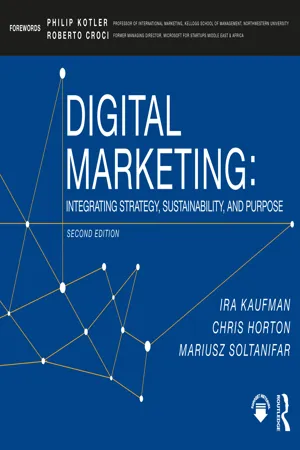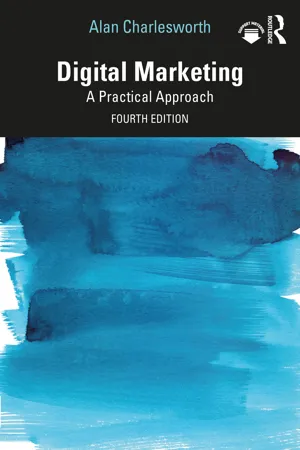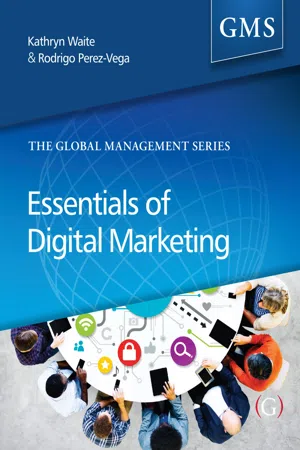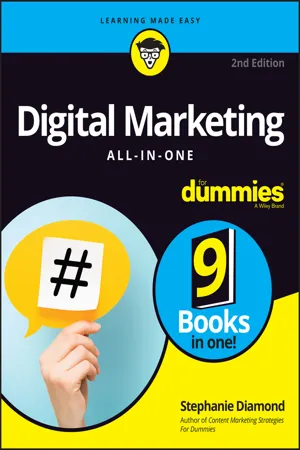Marketing
Digital Marketing
Digital marketing refers to the use of digital channels, such as social media, email, search engines, and websites, to promote products or services. It encompasses various strategies including content marketing, search engine optimization (SEO), and online advertising. Digital marketing allows businesses to reach and engage with their target audience in a more personalized and measurable way.
Written by Perlego with AI-assistance
Related key terms
1 of 5
11 Key excerpts on "Digital Marketing"
- eBook - PDF
Emerging Trends in Business
An Interdisciplinary Approach
- Mehmet Baykal, Halim Kazan, Mehmet Baykal, Halim Kazan(Authors)
- 2018(Publication Date)
- Peter Lang Group(Publisher)
Digital Marketing is a general term for online marketing activities. Online marketing activities include all sorts of digital advertising efforts such as e-mail, social media, search engines, mobile apps, blogs, SMS message, etc. Since dig- ital marketing is a broad terminology, activities of Digital Marketing are not globally agreed on. Digital Marketing is a dynamic concept. The enterprises and entrepreneurs have to continuously follow-up the new developments in order to succeed in Digital Marketing, and have to adapt themselves to these developments. Mehmet Baykal 136 2 Benefits of Digital Marketing Digital Marketing is providing benefits for the companies in many aspects. One of these is the benefit of time. By Digital Marketing, the companies can make the presentation of their products by reaching to numerous customers in a very short while. The research for the requirement of a product, which may take days, weeks and even months, through traditional marketing methods, or raising awareness for a newly presented brand is now taking a very short while. Of course the correct digital channels and correct digital means are required to be used for this to realize. One of the benefits of Digital Marketing for the ones involved in marketing activities is the ability to measure and assess the target audience. By the means of Digital Marketing, the companies can monitor the percentage of the target audience or customers who are receiving the messages of ads, the percentage of them who are interested in the product, the time spent by them on their website, the products searched, whether the visit is turning to sales or not, and prepare reports on them. Reaching this information is very important for each company. By the information obtained, involving in more effective marketing activities becomes easier. - eBook - PDF
- Greg Elliott, Sharyn Rundle-Thiele, David Waller, Ingo Bentrott, Siobhan Hatton-Jones, Pete Jeans(Authors)
- 2020(Publication Date)
- Wiley(Publisher)
12.1 Digital Marketing LEARNING OBJECTIVE 12.1 Identify Digital Marketing activities. Digital Marketing refers to all of the activities involved in planning and implementing marketing in the digital environment, including the internet on computers, tablets and smartphones, and other information and telecommunications technologies. Examples of Digital Marketing include: • the sale of products via an e‐commerce website (at its most basic, the Digital Marketing equivalent of a mail-order service) • the texting of potential customers about a new offer or sale (an example of e‐promotion) • an email sent to an existing customer asking them to click a link to participate in a survey for the opportunity to win a prize (a promotion and customer relationship management technique) • the provision of information, examples and testimonials via social networks (a growing digital channel being used by a variety of businesses, including small companies using Facebook, Twitter, Snapchat, Instagram, LinkedIn and Tumblr and other sites depending on the country) • the use of magazine advertising to encourage consumers to subscribe to an SMS service (an example involving a product and distribution method unique to Digital Marketing) • the inclusion of discount vouchers on takeaway food websites knowing consumers will be able to access a lower price as a result (an example involving promotion, pricing and the active involvement of the purchaser, contrasting with the delivery of pizza discount vouchers via mail which entails no active engagement from the consumer). It is clear then that the internet and other technologies offer numerous opportunities for Digital Marketing. These opportunities are only likely to increase in the future with the younger generation, often referred to as ‘digital natives’ or the ‘net generation’, who are not surprisingly the most prolific users. According to Sensis data, Australians are spending around 10 hours per week on Facebook alone. - eBook - ePub
Digital Marketing Trends and Prospects
Develop an effective Digital Marketing strategy with SEO, SEM, PPC, Digital Display Ads & Email Marketing techniques. (English Edition)
- Shakti Kundu, Dr. Shakti Kundu(Authors)
- 2021(Publication Date)
- BPB Publications(Publisher)
HAPTER 1Introduction to Digital Marketing
D igital marketing can be called as the process of promoting brands or products using electronic media. So what is the difference between Digital Marketing and traditional marketing? What is the current scenario of Digital Marketing? You will find the answer to these questions in this chapter and the subsequent ones. So let’s get started!Structure
In this chapter, we will cover the following topics: 1.1 Introduction to marketing 1.2 Types of marketing 1.3 Evolution of marketing concepts 1.4 Importance and scope of marketing 1.5 Elements of marketing 1.5.1 Needs 1.5.2 Wants 1.5.3 Marketing offers 1.5.4 Consumer value and satisfaction 1.5.5 Markets 1.5.6 Marketer and prospects 1.6 Marketing vs. sales 1.7 Introduction to Digital Marketing 1.8 Benefits and opportunities of Digital Marketing 1.9 Inbound and outbound marketing 1.10 Content marketing 1.11 Understanding traffic 1.12 Understanding leads 1.13 Digital Marketing use in business-to-business (B2B), business-to-consumer (B2C), and not-for-profit (NFP) marketingObjective
After studying this chapter, you should be able to:- Understand the importance and scope of marketing
- Understand the concept of Digital Marketing
- Understand the benefits and opportunities of Digital Marketing
1.1 Introduction to marketing
Marketing is an approach of business functionalities that includes various phases engaged in creating, analyzing, managing, delivering products, and the related services. It also focuses on maintaining customer relationships, resulting in mutual benefits of customers and the stakeholders.It is the technique of choosing the market targets with criteria of market analysis and segmentation. Market analysis is done based on the buying behavioral characteristics of the user. The basic objective of this place is to provide the best customer value. - eBook - PDF
- Brian Thomas, Matthew Housden(Authors)
- 2017(Publication Date)
- Bloomsbury Business(Publisher)
Berners-Lee observes that although search engines index much of the Web’s content, they still have limited ability to select the pages that a user really wants or needs. He suggests developers and authors can use new techniques so that new context-aware software can better classify the information that might be relevant to a user. UBIQUITOUS COMPUTING OR THE INTERNET OF THINGS Ubiquitous computing, also known as pervasive computing, envisages data embedded in everyday objects that enables intercommunication and unobtrusive data sharing throughout the user’s environment. The concept fits easily with that of the Internet of Things in which almost any entity or object imaginable can be equipped with a unique identifier and the ability to exchange data automatically. A modest example of this concept is a fridge that sends a grocery list to one’s smartphone, or indeed direct to a nominated supplier. So ‘Digital Marketing’ is: Applying … digital technologies which form online channels to market; To … support multi-channel marketing activities aimed at achieving profitable acquisition and retention of customers; Through developing … a planned approach to improve customer knowledge (of their profiles, behaviour, value and loyalty drivers), then delivering integrated targeted commu-nications and online services that match their individual needs. The second part of this definition emphasizes that it should not be the technology that drives Digital Marketing, but the business returns from gaining new customers and maintaining DIRECT AND Digital Marketing TODAY 5 relationships with existing customers. In using the expression ‘multi-channel marketing’ it also emphasizes how Digital Marketing does not occur in isolation, but is most effective when it is integrated with other communication channels such as phone, direct mail or face to face. - eBook - PDF
Digital Marketing
Integrating Strategy, Sustainability, and Purpose
- Ira Kaufman, Chris Horton, Mariusz Soltanifar(Authors)
- 2023(Publication Date)
- Routledge(Publisher)
For example, a trade show banner displaying a website URL and social share buttons is understood as a piece of Digital Marketing content, as the action it intends to initiate is, in whole or in part, a digital one (e.g., visiting a website or social platform). This places marketing channels long considered traditional, such as print media and TV and radio spots, squarely under the digital banner (increasingly, these channels are leveraging some kind of digital-dependent call-to-action, whether to visit a website, engage on social media, download a mobile app, etc.). 163 On a practical level, much of this may seem like semantics. Still, it’s important to recognize, especially for the many business and marketing executives dismissive of digital who’ve lost revenue, customers, and market share. Digital Marketing Must Be Integrated If we’re prepared to acknowledge that virtually all marketing is now Digital Marketing, we must also understand that Digital Marketing must be integrated to function properly. The growing size and complexity of the Digital Marketing (and marketing technology) landscape necessitates an integrated approach. Organizational and marketing silos must be torn down; communications processes must be reworked; long-held paradigms must be shattered; marketing orthodoxy must evolve. To respond to the greater sophistication and heightened expectations of the hyper-connected global consumer and to meet the formidable challenges of the digital marketplace, organizations need IDM. “Organizations must embrace Digital Marketing activities in the current business environment” TRANSITION TO DIGITAL INTEGRATED Digital Marketing DEFINED INTEGRATED Digital Marketing 164 IDM is a comprehensive marketing strategy that merges multiple digital channels, platforms, and media to help organizations achieve their goals by providing value for, and building sustainable relationships with, all stakeholders. - eBook - ePub
Digital Marketing in Practice
Design, Implement and Measure Effective Campaigns
- Hanne Knight, Lizette Vorster, Lizette Vorster Larsen(Authors)
- 2023(Publication Date)
- Kogan Page(Publisher)
Digital Marketing campaigns are more operational and tactical in their execution and usually run over a much shorter time frame.KEY TERMDigital Marketing campaigns A Digital Marketing campaign is a focused, tactical initiative to achieve specific Digital Marketing goals.SOURCE Rego, 2017This key term definition highlights one of the essential differences: the time factor. Whereas a Digital Marketing strategy should be set for several years, a Digital Marketing campaign can be executed in a few weeks. Some campaigns are instantaneous and last only a few hours to a couple of days. This can be the case when businesses aim for content to go viral within a brief period. Overall, one can describe Digital Marketing campaigns as the individual building blocks that together form the execution of the overarching marketing strategy.Unique features of digital technology in marketing campaigns
Digital technology enables many different channels and forms of execution to be used when it comes to Digital Marketing campaigns. The opportunities that digital technologies offer in executing Digital Marketing campaigns are endless. In the following section, we will discuss the unique features of digital media and how they aid in running a successful Digital Marketing campaign. - eBook - PDF
Applied Marketing
Connecting Classrooms to Careers
- Daniel Padgett, Andrew Loos(Authors)
- 2019(Publication Date)
- Wiley(Publisher)
Omnichannel marketing seamlessly integrates con- sumer interactions with brands across multiple platforms and multiple occasions. • Digital media will increasingly be consumed on mobile devices. Use of mobile devices is growing while traditional media consump- tion such as TV viewership is declining. • Online reviews are becoming the new word-of-mouth in marketing. • Brand communities are formed as people coalesce around brands through their shared brand connections. Digital media can pro- vide an infrastructure to create and grow brand communities. 12.3 Social Media in Digital Marketing Strategy • The number of social media platforms is growing worldwide, with many becoming specialized to particular consumer characteristics. Facebook still dominates social media. • Social media marketing is proving to be a powerful marketing tool, benefiting marketers with improved financial performance, better customer data and insights, and very low costs. • Social media marketing begins with deep knowledge of a brand’s audience, coordinated messaging across platforms, the need for simple visual appeals, timely responses to customer complaints, and the need for quality content favored over content quantity. • Going forward, social media will experience trends such as employee brand advocacy through social media, an explosion in the importance of messaging, increasingly immersive technology, and the rise of influencer marketing. 12.4 Other Digital Platforms in Marketing Strategy • Company websites remain a staple of Digital Marketing because of the absolute control and ownership of design, structure, and content. Effective websites follow well-established principles of design that emphasize ease of use and navigation. Search engine optimization is important for company websites as they try to be near the top of search results lists produced by search engines such as Google. - eBook - ePub
Digital Marketing
A Practical Approach
- Alan Charlesworth(Author)
- 2022(Publication Date)
- Routledge(Publisher)
I take this as an indication that it is accepted that content development/marketing is accepted as an element of SEO – as I do in Chapter 4. Anyhoo … if we consider HubSpot's data purely in relation to this book, it does give an indication of the use of digital channels. The report also highlights that few of these channels are stand alone, with several being used in sync with others, e.g. content marketing can be used to direct customers to a website or engage on social media. 3.2 DIGITAL ISN'T THE ONLY OPTION Although it may seem strange in a book on Digital Marketing written by someone who has been an advocate of the discipline for over 25 years, but marketers should always be aware that digital is just one aspect of marketing. Indeed, in the main, it is only one element of the promotional mix. Too often, Digital Marketing in general, and social media marketing in particular, are mistakenly perceived as; (a) the only route to market, and (b) a panacea that will improve bad marketing in other channels. Certainly, digital has revolutionized some industries in a way unimaginable before the Internet came along. For example, who books a hotel or flight anywhere else other than online these days? Similarly, for some products and services, the web plays an essential part in consumers' purchase decision-making process. However, for many products, if the marketer puts them in the right place at the right time at the right price then customers will buy them – the ongoing success of Aldi and Lidl (neither of which sell online) is evidence of this. If you doubt this notion, try this simple exercise that I asked my students to complete in the first week of my Digital Marketing modules. List all of your purchases – of products and services – over the last week or month (longer is better) and divide that list into two sections: (1) those where the Internet played a part, and (2) where the Internet played no part - eBook - PDF
Small Business Start-Up Kit, The
A Step-by-Step Legal Guide
- Peri Pakroo(Author)
- 2024(Publication Date)
- NOLO(Publisher)
Whether you want to send out simple marketing emails for your interior design business or you need a robust e-commerce operation for your online pet products company, this chapter will help you develop a realistic strategy for selling and marketing online. We’ll discuss a wide range of e-business issues, including: • how to develop a digital strategy that complements and supports your business strategy overall • the best methods and tools to promote your business online, including email marketing, blogs, and social media • how to drive traffic to your site and convert those visitors into customers • details involved with e-commerce (online sales), including merchant accounts, payment gateways, and shopping carts • how to evaluate alternatives, such as template-based website builder services or opening an affiliate store with e-commerce sites like Amazon, eBay, or Etsy • the basics of registering your domain name and setting up a hosting service, and • legal rules governing ownership of and copyright to your site’s content. Digital Marketing: Your Online Presence Before we get into specific marketing tools and techniques, let’s consider your overall online presence. By “online presence,” we mean all the places a customer or potential customer might encounter your business. These places include: • Your website, which might include a blog. • Any site where customers can buy your product or service, such as an Amazon store, Etsy store, or Fiverr profile. • Social media channels (Instagram, Facebook, YouTube, Reddit, etc.). This is often where businesses are the most active with their marketing communications. Some social channels like Facebook allow e-commerce directly from the social channel, without having to direct visitors to a separate online store. • Your Google Business Profile, which provides information about your business to people searching for that kind of business. Customer reviews at your Google Business Profile can have a major impact on sales. - eBook - PDF
- Kathryn Waite, Rodrigo Perez Vega(Authors)
- 2018(Publication Date)
- Goodfellow Publishers(Publisher)
11 1 Digital Marketing Mix Exercise 1.1 It is not uncommon to see different pricing models even within the same industry. A good example of this would be online counselling, where different competitors have chosen to differentiate based on their pricing models. Conduct a web search of the main providers of online counselling and map out the different pricing strategies that they follow. Promotion Promotion is defined as the element in the mix that looks to communicate with the target audience to generate awareness and increase sales. The pro-motional mix includes advertising, sales promotion, personal selling, public relations and direct marketing. Digital channels can be classified into three major categories: owned, earned and paid media channels (Fill, 2009). Table 1.3: Media types and digital platforms Media type Examples of digital platforms Owned media: digital channels that the brand owns and can control. Company website Company blog Facebook Fan page Organisation’s Twitter account Paid media: brand paying to appear on third-party websites. Display ads (banners) in third party websites Sponsored posts in third party blogs Earned media: brand mentioned on third-party websites without payment involved. Non-paid mentions in third party websites Mentions in social media (Facebook, Twitter, blogs). User reviews Owned media Owned media are the channels that the company owns and has full control over. In the digital context, the most obvious example would be the company’s website. However, the proliferation of channels in particular social media results in businesses ‘owning’ other social channels, such as a Facebook Page or a Twitter account. This trend of extending owned channels is becoming the norm among both large and small organisations. According to eMarketer (2014) 88% of Fortune 500 companies were already using at least one type of social media website. - eBook - PDF
- Stephanie Diamond(Author)
- 2022(Publication Date)
- For Dummies(Publisher)
1 Creating Your Digital Marketing Strategy Contents at a Glance CHAPTER 1: Developing Your Overall Digital Strategy 7 Understanding the Components of a Digital Marketing Strategy 7 Communicating Your Mission 12 Establishing Your Goals 16 Expanding Your Corporate Mindset 18 Dipping into User Design and Habits 22 CHAPTER 2: Grabbing Your Customer’s Attention 25 Focusing on Attention 26 Making Your Content Easy to Consume 30 Deploying Interactive Content 36 CHAPTER 3: Discovering Your Business Model and Brand 39 Separating Your Business Model from Your Brand 40 Analyzing Your Business Model 48 Discovering Your Brand 50 Positioning Your Brand 53 Solidifying the Look of the Brand 60 Developing Success Measures for Your Brand 63 Producing Engaging Branded Content 64 CHAPTER 4: Deciding which Marketing Campaign to Create 67 Establishing Marketing Objectives 68 Defining a Digital Marketing Campaign 69 Understanding the Three Major Types of Campaigns 72 Balancing Your Marketing Campaign Calendar 77 Choosing the Campaign You Need Now 78 Viewing Your Digital Marketing through the Campaign Lens 79 CHAPTER 5: Crafting Offers That Sell 81 Offering Value in Advance 82 Designing an Ungated Offer 83 Designing a Gated Offer 84 Designing Deep-Discount Offers 94 Maximizing Profit 99 CHAPTER 6: Planning B2B Campaign Success 103 Setting Key Performance Indicators 104 Testing Your Campaigns 113 Knowing You Aren’t Wasting Money 115 CHAPTER 1 Developing Your Overall Digital Strategy 7 Developing Your Overall Digital Strategy C ompanies have recognized what their customers have always known. If they can’t find the content that makes your product easy to use and enjoy, they are off to seek out your competitor. You’ve missed the opportunity to impress them or, in some cases, even get on their radar screen. This chapter covers what goes into creating a Digital Marketing strategy. Without it, you can’t get the traction you need to beat the competition.
Index pages curate the most relevant extracts from our library of academic textbooks. They’ve been created using an in-house natural language model (NLM), each adding context and meaning to key research topics.










